 According to the taxonomy of living things, the phylum chordata (animals with backbones) is divided into five classes: fish, amphibians, reptiles, mammals and birds. Water covers over three-quarters of the earth’s surface. The fishes that live there, limbless cold-blooded animals with gills and fins, are the most numerous of the vertebrates, with over 34,000 species. Species range from the primitive jawless lampreys and hagfishes through the cartilage-skeletoned sharks, skates, and rays, to the incredibly diverse bony fishes.  The study of fishes, the science of ichthyology, is important. Fishes are a moderate but important part of the world’s food supply. This resource, once thought to be unlimited, is now realized to be a finite resource, in a delicate balance with the biological, chemical, and physical factors of the aquatic environment.
The study of fishes, the science of ichthyology, is important. Fishes are a moderate but important part of the world’s food supply. This resource, once thought to be unlimited, is now realized to be a finite resource, in a delicate balance with the biological, chemical, and physical factors of the aquatic environment. Overfishing and poor management, pollution, and changes in the environment are the main challenges to their populations. Fishes range in adult length from less than a centimetre to more than 20 metres, and in weight from about 1.5 grams to many thousands of kilograms. Some live in hot thermal springs at temperatures of 42 °C , others in cold Arctic waters a few degrees below 0 °C. Some fishes live in cold deep waters more than 4 kilometres beneath the ocean surface. There are three major groups of fish:
Let's look at some different types of fishes: The Smallest Fish 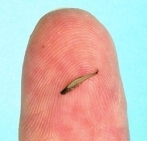 The Stout Infantfish, native to Australia's Great Barrier Reef and to the Osprey Reef in the Coral Sea, is a tiny 7 to 8 millimetres in length when fully grown.
The Stout Infantfish, native to Australia's Great Barrier Reef and to the Osprey Reef in the Coral Sea, is a tiny 7 to 8 millimetres in length when fully grown. It is transparent, without pigmentation except for its eyes, and lacks teeth and scales. The Stout Infantfish is the earth's smallest, lightest animal with a backbone. The Largest Fish 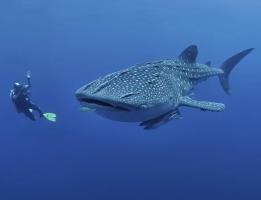
The Whale Shark is a gigantic but harmless shark and is the largest living fish. It inhabits the waters around Australia. Whale Sharks are most commonly between between 4 m and 12 m in length, but can possibly reach a length of 18 m. Whale Sharks can be easily recognised by their colour pattern - the ventral surface is whitish, and the back and sides are blue to blackish with white stripes and blotches. The Most Deadly Fish 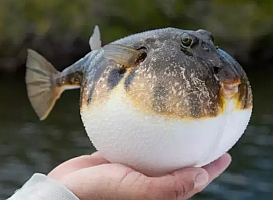 Pufferfish can inflate into a ball shape to evade predators. Also known as blowfish, these poor swimmers can fill their elastic stomachs with huge amounts of water and blow themselves up to several times their normal size.
Pufferfish can inflate into a ball shape to evade predators. Also known as blowfish, these poor swimmers can fill their elastic stomachs with huge amounts of water and blow themselves up to several times their normal size.Most pufferfish contain a toxic substance that makes them not only foul tasting, but potentially deadly to other fish. Their toxin is deadly to humans. There is enough poison in one pufferfish to kill 30 adult humans, and there is no known antidote. The Ugliest Fish 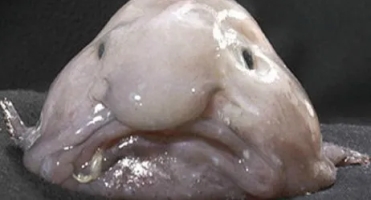 Dubbed the 'ugliest fish in the world' due to its unusual appearance, the blobfish gained internet fame in 2003. There are nine species of blobfish which live deep in the sea mainly off the coast of Australia, at depths ranging from 600 to 1,200 metres These fish have a flabby face, slimy body and bizarre body shape. Its soft tissue is full of water and fat, which both protects the fish from surrounding pressure and enables it to move easily across the sand on the ocean floor.
Dubbed the 'ugliest fish in the world' due to its unusual appearance, the blobfish gained internet fame in 2003. There are nine species of blobfish which live deep in the sea mainly off the coast of Australia, at depths ranging from 600 to 1,200 metres These fish have a flabby face, slimy body and bizarre body shape. Its soft tissue is full of water and fat, which both protects the fish from surrounding pressure and enables it to move easily across the sand on the ocean floor. At those depths, the blobfish more closely resembles a normal fish. It's only when it's brought to the surface where, relieved of the high pressure of the depths which hold the fish together, its water-logged tissue collapses into a traumatized, gelatinous mass. The Scariest Fish 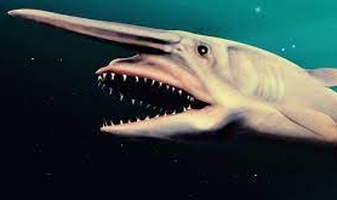 The Goblin Shark is certainly a candidate for this category. Its long nose gives it a unicorn look. Its pink flesh makes it look like it has no skin. And then there's the teeth ...
The Goblin Shark is certainly a candidate for this category. Its long nose gives it a unicorn look. Its pink flesh makes it look like it has no skin. And then there's the teeth ...This fish is large; one specimen, caught in the Gulf of Mexico, was 6 metres long. They are slow swimmers. They don’t chase their prey; instead, they wait quietly. When a fish gets close, the Goblin’s jaws instantly extend out of their mouth and snap shut, slicing into it or devouring the prey whole. Fish That Fly 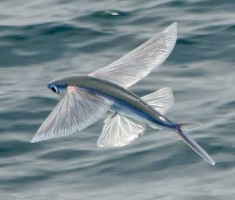 The Exocoetidae are a family of ray-finned fish known as flying fish. While they cannot fly in the same way a bird does, flying fish can make powerful, self-propelled leaps out of the water where their long wing-like fins allow them to glide for considerable distances above the water's surface.
The Exocoetidae are a family of ray-finned fish known as flying fish. While they cannot fly in the same way a bird does, flying fish can make powerful, self-propelled leaps out of the water where their long wing-like fins allow them to glide for considerable distances above the water's surface. The main reason for this activity is thought to be to escape from underwater predators, which include swordfish, mackerel, tuna, and marlin. Their periods of flight, however, expose them to attack by predators such as frigate birds. Fish That Walk on Land 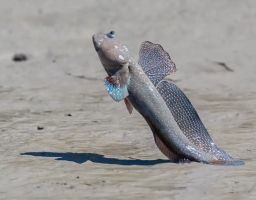 There are a number of fish that walk, including the Northern snakehead, Mudskippers, the Pacific leaping blenny, Climbing perch,
Walking catfish, and Mangrove rivulus. Let's have a look at one of them, the Mudskipper.
There are a number of fish that walk, including the Northern snakehead, Mudskippers, the Pacific leaping blenny, Climbing perch,
Walking catfish, and Mangrove rivulus. Let's have a look at one of them, the Mudskipper.Shown at the left, Mudskippers are found in waters from Africa to Polynesia and Australia. They live in swamps and estuaries and on mud flats, and are noted for their ability to climb, walk, and skip about out of water. They can be up to about 30 cm long. They have two dorsal fins, and their pelvic fins are forward under the body, either partly or completely fused. Their blunt heads are topped by large, movable, close-set, protuberant eyes, and their strong pectoral fins help them to move on land. Out of water, they breathe with air trapped in their gill chambers as well as through the skin. They prey on crustaceans and other small animals. Fish That Live the Deepest 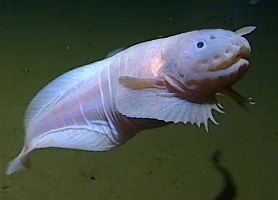 The Snailfish is a small, bizarre-looking fish, found at a depth of more than eight kilometres, that's considered the deepest fish ever recorded. Scientists exploring a marine trench near Japan were astonished to see the tadpole-shaped, translucent snailfish in one of the deepest parts of the ocean, at 8,336 metres below the surface.
The Snailfish is a small, bizarre-looking fish, found at a depth of more than eight kilometres, that's considered the deepest fish ever recorded. Scientists exploring a marine trench near Japan were astonished to see the tadpole-shaped, translucent snailfish in one of the deepest parts of the ocean, at 8,336 metres below the surface. The previous record holder, a snailfish seen in the Mariana Trench, the world's deepest location, was filmed at 8,178 metres under the surface in 2017. The Most Numerous Fish 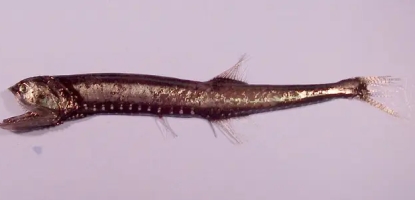 The Bristlemouths are considered the most numerous fish on the planet, exceeding even the plentiful herring in numbers, and are also the most numerous vertebrate. Bristlemouths are deep sea fishes, and, adapting to their pitch-black habitat, have rows of light-emitting organs called photophores along their sides. These fishes form a key component of the ocean food web.
The Bristlemouths are considered the most numerous fish on the planet, exceeding even the plentiful herring in numbers, and are also the most numerous vertebrate. Bristlemouths are deep sea fishes, and, adapting to their pitch-black habitat, have rows of light-emitting organs called photophores along their sides. These fishes form a key component of the ocean food web.
The Most Expensive Fish 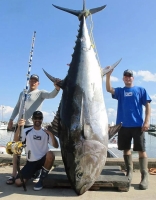
With a record-setting $3.1 million selling price for one particular fish, the Bluefin Tuna is the most expensive fish in the world. The price was obtained at an auction in Japan in 2019. The Bluefin Tuna is typically used for making sushi, and it’s illegal to own for private use in most countries. On the other hand, they can be found in commercial aquariums, and are bred in captivity in Japan and South Korea. |